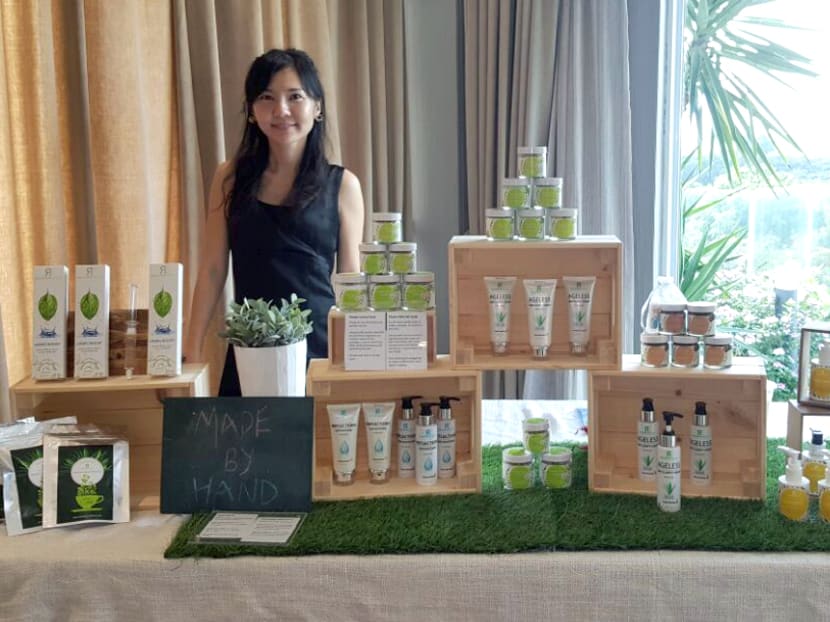Growing demand for less toxic beauty products
SINGAPORE — Greater awareness of hazardous chemicals in beauty products has driven demand for less toxic versions and spurred homegrown brands to omit certain nasties from their products.

Ms Sara Davina Soong co-founded Restoration Essence, a natural skincare and health food brand, in 2016.
SINGAPORE — Greater awareness of hazardous chemicals in beauty products has driven demand for less toxic versions and spurred homegrown brands to omit certain nasties from their products.
Ms Caryn Lim, co-founder of Coat, Singapore's first non-toxic nail brand, noticed a demand for non-toxic nail polishes in 2012 while she was running a nail spa business. Back then, the non-toxic brands available tended to be difficult to use or it was hard to maintain a nice layer of polish with them, said Ms Lim.
When she started Coat with her co-founders in 2014, the initial challenge was finding a formula that could achieve a good look and finish without the harsh ingredients.
Coat’s quick-drying formula is eight-free, meaning it excludes eight ingredients found to have potential harmful side effects — among them the controversial toxic trio of dibutyl phthalate (DBP), toluene and formaldehyde.
“Due to the potential harmful side effects of these eight ingredients, I knew I had to exclude them (in Coat’s products). But we did manage to find a formula that could give customers the satisfaction of a shiny and lasting lacquer without the harmful side effects,” she said.
Ms Sara Davina Soong’s customer base has grown two to three times since she co-founded Restoration Essence, a natural skincare and health food brand, in 2016. Back then, her customer base was around 100 to 200.
“Consumers are more aware now, and they are looking for products with less chemicals,” she said.
While there are challenges with excluding conventional chemicals from beauty products, business owners said the effort is worth it when customers provide positive feedback.
“Some products (with more potent preservatives) can be used for up to three years, compared to four to eight months for my products. Besides affecting the shelf life, omitting certain chemicals like synthetic stabilisers may also affect the ‘feel’, texture and consistency of the product,” said Ms Soong.
“The product may feel a bit more ‘raw’, and you may notice the sediments. But this is all part of going natural,” she said.
ARE NATURAL PRODUCTS ALWAYS A SAFER BET?
Some experts say that natural or organic products are not necessarily safer.
“Just because a product is labelled organic or natural does not mean there are no other chemicals used to produce or preserve it,” said Dr Elias Tam, founder and medical director of EHA clinic.
Natural ingredients like plant products (such as aloe vera, lavender, cinnamon, citrus oil and other essential oils) can also cause adverse reactions, he added.
Health risks can also arise from the leaching of chemicals from packaging materials, said Associate Professor Ho Han Kiat from the department of pharmacy, faculty of science, at the National University of Singapore.
Ms Soong said natural products may not be totally preservative-free. She avoids using controversial preservatives like parabens and chooses “more natural”, safer ones such as vitamin E derivatives for her products.
“Brands use the term ‘natural’ when they add natural ingredients like sources derived from plants in their products but it does not mean they do not contain preservatives,” she said.
And not all natural product brands are equal, she added.
“The benchmark (for most independent natural beauty brands) is 60 to 70 per cent natural ingredients. But some of the bigger brands that I’ve come across do not follow this. Their products contain less than 60 to 70 per cent natural ingredients,” said Ms Soong.
It is also important for those using natural products with less preservatives to store and use them properly due to their shorter shelf life.
“For example, I’ll advise my customers to keep the products away from water and not store them in the bathroom. Store the products in the fridge as the cold temperature inhibits bacteria or mould,” said Ms Soong.






